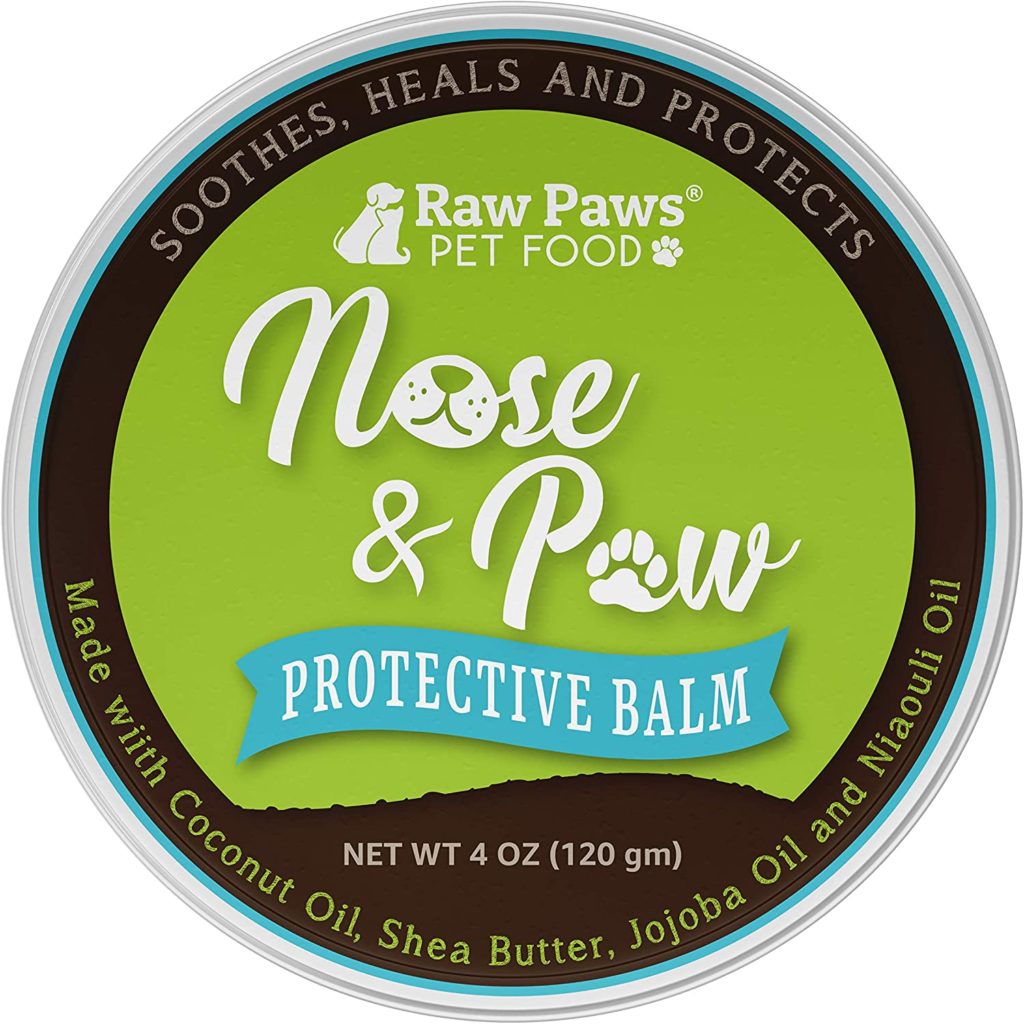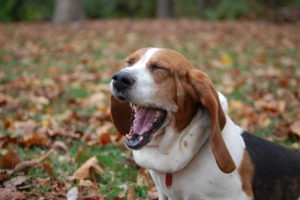Finding the best dog nose balm on the market can be difficult. The longer you look at the ingredients, the more intimidated you get.
Thankfully, our experts have pored over the data and reviews to find the best dog nose balms on the market.
Our top picks are below:
- Best Overall: Nozzle Nectar 100% Organic and Natural Dog Nose Balm Buy on Amazon or Read Full Review
- Premium Choice: 4-Legger Organic Nose and Paw Pad Healing Balm Buy on Amazon or Read Full Review
- Budget Friendly: Bag Balm Skin Moisturizer Buy on Amazon or Read Review
If you want to read more about dog nose balms, how to use them, and how we chose our list make sure to jump to the bottom of this page before reading our reviews.
Nozzle Nectar uses a minimum number of ingredients to get a maximum benefit. A base of beeswax gets combined with sunflower seed oil, lanolin, coconut oil, and avocado oil to provide a thick dog nose balm your dog won’t lick off easily. Then they throw in some extra vitamin E to keep their nose tissues happy and healthy. It’s a simple recipe that gets satisfactory results – with no unwanted scents to offend your pup’s sniffer. Plus, you get a 100% satisfaction guarantee! (Who doesn’t love those?). Finally, you can’t beat the price on this one.
The downsides? This is one of the harder dog nose balms out there. You’ll want to allow it to warm in your hands for a few minutes before trying to apply it. Also, coconut oil and dogs are still up in the air. Be careful how much of the balm your dog ingests.
The Good
- Contains sunflower seed oil, cocoa butter, lanolin, and avocado oil
- Unscented
- Includes vitamin E
- Affordable
The Bad
- Hard texture
- Contains coconut oil
4-Legger takes their dog nose balm that little extra mile. They use shea butter as the base, and they source it from land that supports a hippo sanctuary in West Africa! Then they mix in carnauba wax, hemp oil, calendula, and St. John’s wort – with no scent to worry about. And if you’re worried about ingredients, they have that USDA Organic seal of approval. The balm works well on noses, paws, elbows, and even skin. The company was founded by a doggie mom who won her battle with cancer and wanted to put positive energy out in the world.
Downsides? People complained the container was on the small side for the cost. If you only use it for your pup’s nose, it should last longer. It does have a “buttery” texture, though. That may or may not work for some dogs (or people). You DO need to watch them with the St. John’s wort. It can lead to problems the more they ingest.
The Good
- Contains shea butter, carnauba wax, and hemp oil
- Unscented
- USDA-certified organic
The Bad
- Small container for price
- Buttery texture
- St. John's wort can lead to problems if ingested
Okay, so Bag Balm ISN’T specifically formulated for dogs. What’s its claim to fame? When the police dogs that worked in New York following 9/11 needed relief, Bag Balm was the dog nose balm they turned to! People have also taken it on Antarctica expeditions (where you KNOW the icy air sucks the moisture right from the skin). There are only four ingredients: petrolatum, lanolin, paraffin wax, and an antiseptic. Bag Balm got its start in 1899 in Vermont, helping dairy cows stay comfortable. (I won’t go into details, but suffice to say we’re dealing with another sensitive area) Your dog’s nose gets moisture, softening, and protection, all at the same time. And that little green tin won’t break the bank.
The downsides? The smell is STRONG. Your dog may not appreciate it. And while petrolatum IS safe, you don’t want a thick coat around the nostrils. Too much can lead to inhalation pneumonia. And if they ingest too much, you’ll see an upset stomach.
The Good
- Inexpensive
- Contains lanolin and paraffin wax
- Used by police dogs following 9/11
The Bad
- STRONG smell
- Petrolatum can cause an upset stomach if ingested
How would you like to add some personalization to your dog nose balm? Blissful Dog will let you pick out breed-specific labels (they have 70 to choose from). They start with a base of shea butter and cocoa seed butter, then mix in beeswax, olive oil, castor oil, avocado oil, almond oil, and coconut oil. The combination provides the perfect mixture of moisture, relief, and protection for your dog’s nose. You can choose between tins OR tubes, both in multiple sizes, to suit your particular needs. You also have the option of a scented or unscented version.
So what are the downsides? Castor oil IS considered a neutral oil, but if your dog ingests enough of it, they’re going to end up with an upset stomach. Add in coconut oil, and things get a little iffy. Also, the scented version uses essential oils – including Ylang Ylang, which is toxic to dogs. Stick to the unscented version to be on the safe side.
The Good
- Contains shea and cocoa seed butter, beeswax, and neutral oils
- Available in tins or tubes
- Comes scented or unscented
- Customizable labels
The Bad
- Castor oil will upset stomach if ingested
- Contains coconut oil
- Scented version contains Ylang Ylang essential oil
For a completely versatile dog nose balm, look no further than Burt’s Bees. They combine beeswax, jojoba butter, olive oil, honey, and rosemary into a soft lotion that keeps your dog’s nose (or paws or elbows) soft and moisturized. And since it’s Burt’s Bees, you know it’s manufactured in the U.S. and completely cruelty-free. Despite the olive oil, it doesn’t feel greasy, and it WON’T leave stains or streaks on your furniture (important if your dog pokes their nose into the cushions).
Downsides? Unhappily, it smells and tastes good. So dogs enjoy REMOVING it from their noses. (It works a little better on paws) It’s a thinner barrier than other dog nose balms, though, which DOESN’T work well for paws. (Kind of a catch-22)
The Good
- Contains beeswax, jojoba butter, and olive oil
- Cruelty-free
- Not greasy and won't stain
The Bad
- Smells and tastes good
- On the thin side
When your dog faces the problem of hyperkeratosis (an overgrowth of the skin on their nose or paws), you want a tough product. And Ruff Relief is one of the dog nose balms out there that owners trust for their poor pups. The USDA-certified organic ingredients start with beeswax, jojoba wax, and carnauba wax, then they add in olive oil and coconut oil. They don’t add essential oils; in fact, there’s no scent whatsoever to cause problems. The balm absorbs quickly, preventing any problems with a greasy texture. And you have a 30-day satisfaction guarantee, just in case you need it.
So what are the downsides? You saw it – that pesky coconut oil sneaking in again. Monitor how much your dog decides to snack on. Also, the tin’s on the small side for many people (it DOES work for paws, too). And while it’s not greasy, it WILL leave marks on your furniture. You may want to put it on your dog’s snout and then block them from any couches or cushions you’re attached to.
The Good
- Contains beeswax, jojoba wax, carnauba wax, and olive oil
- Unscented
- Includes vitamin E
- USDA-certified organic
The Bad
- Small container
- Contains coconut oil
- Will leave marks on furniture
Snout Magic claims to work “like magic in 3 days.” And it certainly has a formula that can do the trick. They start with shea butter, cocoa butter, and beeswax, then add in neutral oils: olive oil, almond oil, coconut oil, avocado oil, and castor oil. (And, in case you miss it, “love” is also a key ingredient) And while it’s NOT listed, the essential oil is cypress, which isn’t on the toxic list. It also doesn’t add any scent to the product.
Downsides? There ARE organic labels everywhere, but they’re not official, so they don’t count. (If it’s not a USDA Organic stamp, it’s decoration) However, the label includes both coconut oil AND castor oil. Watch your dog’s GI tract closely if they ingest it.
The Good
- Contains beeswax, shea butter, cocoa butter, olive oil, almond oil, and avocado oil
- Unscented
- Includes cypress essential oil
The Bad
- Not actually organic
- Castor oil will upset stomach if ingested
- Contains coconut oil
Snout Soother does double duty: it works as a dog nose balm AND a dog sunscreen. (And, if you really want, it’s safe enough for YOUR nose!) They work with all-natural ingredients, including shea butter, hempseed oil, jojoba oil, coconut oil, grapeseed oil, rosemary extract, and chamomile. You won’t have to worry about a scent to upset your hound, either. And with the handy stick applicator, it’s a breeze to apply.
The downsides? Coconut oil rears its head yet again. Monitor your kiddo closely if they ingest a lot of this dog nose balm. Also, considering the stick’s size, this is one of the more expensive options out there.
The Good
- Contains shea butter, hempseed oil, jojoba oil, grapeseed oil, and chamomile
- Unscented
- Easy stick applicator
The Bad
- Expensive
- Contains coconut oil
Raw Paws is mostly famous for pet food, but their nose and paw balm is a great addition to the category. The non-toxic and natural formulation contains niaouli and calendula oils, essential oils that can accelerate healing. The 4 oz tin is double the size of most products on the market but costs less, giving you more bang for your buck.
On the downside, the balm contains coconut oil which can be toxic to dogs in large quantities. It also contains aloe vera, another problematic ingredient that may be unsafe
The Good
- Great price
- Unscented
- Large size
The Bad
- Contains aloe vera
- Contains coconut oil
How Dog Noses Work
We know dog noses are better than ours. Their smell sensitivity is ONE THOUSAND times greater than ours. As Dr. David Dorman, a Professor of Toxicology at North Carolina State University points out, “It’s like finding proof that a packet of sugar has dissolved in an Olympic-sized swimming pool.”
What makes dog noses so adept at smelling? The nostrils move separately. So they can take in scents from TWO sides at the same time. Some particles get trapped on the nose’s wet exterior, but others go down into the lungs. Then, as they breathe out, the NEW smells pass through the slits in the nose. Your dog constantly has smells moving through their snout!
But what happens when your dog’s nose is dry? Smells start to get lost.
Why Do Dog Noses Dry Out?
Dogs rely on their noses A LOT. And they’re sensitive parts of the body. (If you’ve ever endured a long cold, with endless streams of nose-blowing, you understand) Delicate body parts often succumb to problems. And noses are no exception:
- Infections
- Inflammation
- Immune-mediated diseases
- Trauma
- Tumors
When you see signs of problems with your dog’s nose, it’s time for a trip to the vet. You want to make sure you’re not dealing with a larger concern BEFORE you reach for any dog nose balms. And you want to discuss the potential dog nose balm with your vet before you start applications. If there’s an infection, you’ll block the healing process. Safety first!
Understanding Dog Nose Balms
Dog nose balms work by gently lubricating the soft tissue of your canine’s sniffer. They return missing moisture. You’ll also find soothing ingredients that calm down the inflammation causing your dog to feel miserable.
Left untreated, dry noses lead to further problems. If your dog feels irritated, they can start to paw at their snout, leading to scratches and potential infections.
Dog nose balms help keep your pup feeling relieved – even in the worst winter air. And for brachycephalic breeds – such as Bulldogs or Pugs – they’re a lifesaver. These kiddos often have dry noses from their anatomy. With difficulty breathing on a normal day, they can’t keep moisture moving through their nasal passage. Dog nose balms keep their cute little button noses healthy.
Can I Use My Moisturizer on My Dog’s Nose?
When your nose starts to burn and crack, you reach for lotion. And it’s tempting to use the same bottle on your pooch. Why spend more on a dog nose balm? Because human lotions often contain ingredients that are TOXIC to dogs!
What’s the first thing dogs do when you put something on their nose? They lick it off. It’s the conundrum that comes with dog nose balms. (Which is why you MUST talk to your vet before starting one!) They’re going to ingest the balm – it’s inevitable. Which means you need something SAFE.
You CANNOT use anything containing the following:
- Calcipotriene: A common psoriasis medication
- Diclofenac: A joint pain medication
- Hydrocortisone: Often found in calamine lotion
- Lidocaine: A numbing agent
- Vitamin D: Great for the skin, but when ingested in large amounts (say, from daily use), it leads to vitamin D toxicosis
- Zinc oxide: Used in diaper rash creams and sunscreens
How to Choose a Dog Nose Balm
The nice thing about dog nose balms is they work on more than just the sniffer. You can often use them on paws and even the elbows. So while you DO need to find something specific to canines, you have multiple options available for use. However, you’re using a product on a sensitive part of the body, and you’re purchasing something your dog WILL ingest. That means paying special attention when you do your shopping.
- Ingredients: You need to look at the ingredient label carefully. Are there toxic essential oils? What about castor oil? You don’t want to upset your dog’s stomach.
- Material: What’s the base of the dog nose balm? Is it oil, wax, or butter? Each works a little differently, and a combination of the three covers all the bases for a healthy snout.
- Odor: This is going on your dog’s NOSE. They have to smell it for how long? (I mean, likely until they lick it off) You may think a scent is pleasant, but they won’t. And if it’s TOO pleasant, you’ll encourage them to lick the dog nose balm off in seconds.
- Price: Unhappily, dog nose balms fall into the category of “you get what you pay for.” You’re dealing with a sensitive area, and you want to aim for the best possible option.
How to Use Dog Nose Balms
No one wants to see their poor dog’s nose cracked, dry, and irritated. And changing seasons do a number on a canine snout. Once you’ve made your appointment to chat with your vet about the state of your dog’s nose, you can consider dog nose balms to provide comfort and relief.
If you already know which balm you want to work with, bring it to the appointment. You and your vet can discuss application frequency, what to watch for, AND review the ingredients one more time.
There’s nothing wrong with using dog nose balms, but you need to do so SAFELY. Dog noses are important and sensitive. You don’t want to cause further damage. And you don’t want to cause an upset stomach when your inquisitive canine decides to lick the nose balm off. Coordinate with your vet, and everyone will stay happy and healthy.
Conclusion
Dog noses are incredible creations. They detect disease, body heat, changes in emotion, and even the dinner you’re preparing. So you want to take the best care of them possible. And when you see signs of drying, cracking, and irritation, you want to do whatever you can. Dog nose balms can help – AFTER you’ve checked with the vet.
Balms go a long way toward making a nose feel better, but they can also make an underlying problem WORSE. Chat with your vet and get the “all clear” first. Then you can apply a soothing dog nose balm to bring some relief as the seasons do their dance. It’s the best option – for everyone.















No comment yet, add your voice below!